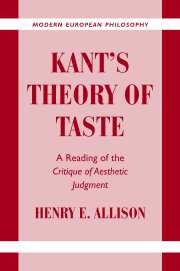Book contents
- Frontmatter
- Contents
- Acknowledgments
- Note on Sources and Key to Abbreviations and Translations
- Introduction
- PART I KANT'S CONCEPTION OF REFLECTIVE JUDGMENT
- PART II THE QUID FACTI AND THE QUID JURIS IN THE DOMAIN OF TASTE
- PART III THE MORAL AND SYSTEMATIC SIGNIFICANCE OF TASTE
- PART IV PARERGA TO THE THEORY OF TASTE
- 12 Fine Art and Genius
- 13 The Sublime
- Notes
- Bibliography
- Index
12 - Fine Art and Genius
Published online by Cambridge University Press: 18 January 2010
- Frontmatter
- Contents
- Acknowledgments
- Note on Sources and Key to Abbreviations and Translations
- Introduction
- PART I KANT'S CONCEPTION OF REFLECTIVE JUDGMENT
- PART II THE QUID FACTI AND THE QUID JURIS IN THE DOMAIN OF TASTE
- PART III THE MORAL AND SYSTEMATIC SIGNIFICANCE OF TASTE
- PART IV PARERGA TO THE THEORY OF TASTE
- 12 Fine Art and Genius
- 13 The Sublime
- Notes
- Bibliography
- Index
Summary
Apart from the treatment of aesthetic and teleological judgment in a single work, perhaps the strangest feature of the Critique of Judgment, at least to the post-Hegelian reader for whom “aesthetics” and “philosophy of art” are virtual synonyms, is the fact that it is only near the very end of the portion dealing with aesthetic judgment (§43 to be exact) that Kant turns to the topic of fine art. To be sure, we do not find here the first reference to art and artistic beauty. On the contrary, we have seen that references to them are scattered throughout the Analytic of the Beautiful and the Deduction. And we have also seen that in the sections lying between the Deduction and the discussion of fine art, Kant argues that only natural and not artistic beauty is capable of being connected with an intellectual, morally based interest. Nevertheless, as has been frequently noted in the literature, the whole discussion of fine art and its connection with genius has an episodic character about it that makes it difficult to integrate into the overall argument of the work.
As far as the doctrine of genius is concerned, this is hardly surprising, since Kant's fundamental concern is with the nature of aesthetic judgment, not artistic production. In other words, his is what is often termed a “reception aesthetic,” rather than a “creation aesthetic.” In fact, as we have seen, it is a reception aesthetic in which it is assumed from the start that the same principles govern judgments of both natural and artistic beauty.
- Type
- Chapter
- Information
- Kant's Theory of TasteA Reading of the Critique of Aesthetic Judgment, pp. 271 - 301Publisher: Cambridge University PressPrint publication year: 2001

